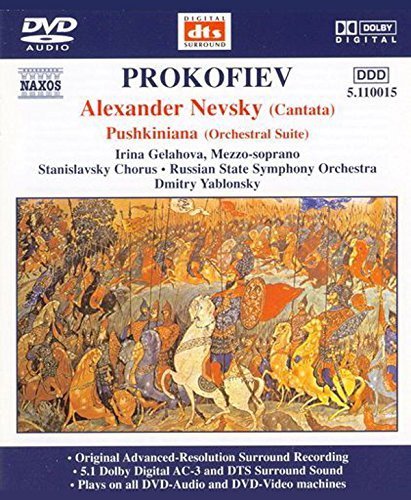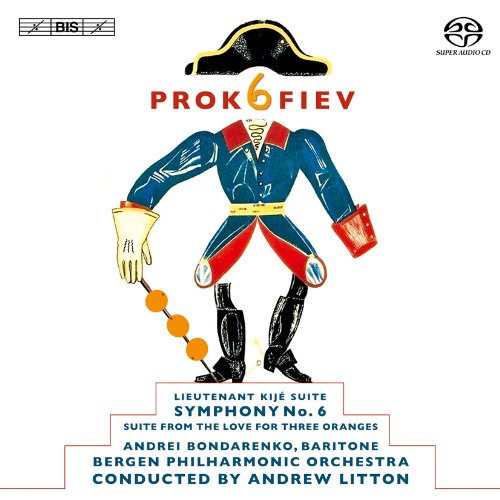Thanks for your review. I will order it along with the Rheinberger organ concerto with Biggs.
You are using an out of date browser. It may not display this or other websites correctly.
You should upgrade or use an alternative browser.
You should upgrade or use an alternative browser.
Dutton Vocalion & Dutton Epoch Surround Sound SACDs (Gerhardt Soundtracks, A Little Night Music, Classical) (Sept 2018)
- Thread starter ubertrout
- Start date

Help Support QuadraphonicQuad:
This site may earn a commission from merchant affiliate
links, including eBay, Amazon, and others.
It really is - gave it a listen today. Far more discrete than a classical recording you'd hear today. In my opinion this is the new top choice in surround for Alexander Nevsky Cantata, and it's a really good performance to boot. Reiner's famous account in Living Stereo (only on AP SACD) is plagued by terrible balances in the 3-channel mix - I suspect it was never meant to be heard like that. And in any case Reiner uses an english translation for some of the movements, which doesn't work that well for me. Slatkin's quad mofi version is fine, but neither the performance nor the acoustics (nor the mix) are as good/interesting) in my opinion. Schippers is good in what I believe is a surround mix sourced from 2 or 3 channel master tapes, but it's not real surround. The only real competition in my opinion is Naxos's DVD-Audio from a dozen years back with modern forces - the acoustics are better but it's much less discrete and the playing isn't quite as good in my opinion.

There's also Slatkin/Saint Louis on Vox Candide, reissued on MoFi. It's a really fine Marc Aubert/Joanna Nickrenz recording, but unlike some of the earlier Voxes that MoFi took on, this one has fairly typical concert-hall ambience in the rears. (That goes for Nevsky, anyway; the recording of Lt. Kije on the same disc--from a different session, originally on Turnabout--has more character and depth, surround-wise.)
But I agree: the D-V Ormandy is the new standard!
- Joined
- Jan 9, 2013
- Messages
- 25,039
Thanks for your review. I will order it along with the Rheinberger organ concerto with Biggs.
The Rheinberger organ Concerto is gorgeous. You will LOVE it!
Usually anything with organ and orchestra becomes an automatic buy, especially given the relative dearth of such recordings.Thanks for the recommendation.The Rheinberger organ Concerto is gorgeous. You will LOVE it!
While Slatkin did some fine work (and on the flip side Ormandy was sliding in his later years), I still think the Ormandy/Philadelphia combination is superior in most pertinent ways.There's also Slatkin/Saint Louis on Vox Candide, reissued on MoFi. It's a really fine Marc Aubert/Joanna Nickrenz recording, but unlike some of the earlier Voxes that MoFi took on, this one has fairly typical concert-hall ambience in the rears. (That goes for Nevsky, anyway; the recording of Lt. Kije on the same disc--from a different session, originally on Turnabout--has more character and depth, surround-wise.)
But I agree: the D-V Ormandy is the new standard!
Still need to listen to the Lt. Kije - there's much more competition there, including a fantastic disc from BIS. That one also uses vocal parts instead of the instrumental version (which I prefer, but whichever).

Imbobman
1K Club - QQ Shooting Star
You guys sold me on the Alexander Nevsky title. Also ordered André Kostelanetz Plays the Music of Villa-Lobos & André Kostelanetz Conducts Music from Spain, Rick Derringer, Poco, The Guess Who & Chase. Let's keep supporting D-V & their great work!
They also do an excellent on packaging .... Last package arrived from the UK to Wisconsin with all jewel cases in perfect condition. Amazon could learn a thing or 2 about this from them.
They also do an excellent on packaging .... Last package arrived from the UK to Wisconsin with all jewel cases in perfect condition. Amazon could learn a thing or 2 about this from them.
I finally gave a dedicated sit-down listen to the Nevsky yesterday, and it's absolutely brilliant. With orchestral music, I've always been inclined to settle for ambiance-in-the-rears, and to be grateful when that takes the form of "big surround" rather than faint echo. But recordings like these (and the DG/Pentatone Boston Symphony discs) make me think we should all be more demanding!
P.S.: Oh--and of course non-classical fans will want to get this one so that they can better appreciate where Greg Lake stole the signature motif for "I Believe in Father Christmas" from!
P.P.S.: And speaking of Lt. Kijé: once again, Michael Dutton proves himself to be not just the master of the remaster, but of the four-channel mix!
P.S.: Oh--and of course non-classical fans will want to get this one so that they can better appreciate where Greg Lake stole the signature motif for "I Believe in Father Christmas" from!
P.P.S.: And speaking of Lt. Kijé: once again, Michael Dutton proves himself to be not just the master of the remaster, but of the four-channel mix!
Last edited:
I haven't yet recieved my copies yet, but am looking forward to them. Which DG/Pentatone discs are you speaking of ?
The typical ones pointed to are the Ozawa/Boston recordings, especially of Berlioz, and the Bernstein recording of Carmen (recently reissued on BD-A by DG itself as well).I haven't yet recieved my copies yet, but am looking forward to them. Which DG/Pentatone discs are you speaking of ?
Finally got to listen to the Lt. Kije Suite, and I'm a little less enthusiastic. The quad mix by Michael Dutton is really good and active - the suite is defined by several different voices in the orchestra at the same time, and he uses the surround mix to really give each voice room to breathe. The problem for me is that the actual performance doesn't have that much energy, at least as much as I expected, and the sound didn't seem that great to me either. I pulled out the BIS release to compare (a bit unfair, I know), and the brass and woodwinds sounded much better and more natural.While Slatkin did some fine work (and on the flip side Ormandy was sliding in his later years), I still think the Ormandy/Philadelphia combination is superior in most pertinent ways.
Still need to listen to the Lt. Kije - there's much more competition there, including a fantastic disc from BIS. That one also uses vocal parts instead of the instrumental version (which I prefer, but whichever).

Still totally worth buying, and if you're new to the piece you'll wonder what I'm talking about.
Thanks for the evaluation. As it turns out, Lt Kije hasn't held much interest for me anyway. I am usually bored by it. I am still waiting for my discs to show up. Hopefully they should be here any day now.Finally got to listen to the Lt. Kije Suite, and I'm a little less enthusiastic. The quad mix by Michael Dutton is really good and active - the suite is defined by several different voices in the orchestra at the same time, and he uses the surround mix to really give each voice room to breathe. The problem for me is that the actual performance doesn't have that much energy, at least as much as I expected, and the sound didn't seem that great to me either. I pulled out the BIS release to compare (a bit unfair, I know), and the brass and woodwinds sounded much better and more natural.
Still totally worth buying, and if you're new to the piece you'll wonder what I'm talking about.
geekzapoppin
New member
- Joined
- Mar 19, 2015
- Messages
- 1
As a huge Sondheim fan, I had to get the Little Night Music SACD. It's... interesting. The Quad mix often seems like channels were arbitrarily chosen, rather than with a cohesive mix in mind. I'm not sure what the thinking behind it was, but it's very off-putting to have vocals on some songs only come from a rear speaker. Some songs are better than others, but the whole thing is very odd, in general. It's probably the most chaotic musical surround mix I've heard. I haven't listened to a great deal of 1970's Quad mixes, so perhaps this wasn't uncommon. Still, I'm glad I have it, just as a unique oddity. It's not something I'll listen to as my main source for the cast album, though.
The Quad mix often seems like channels were arbitrarily chosen, rather than with a cohesive mix in mind.
...
I haven't listened to a great deal of 1970's Quad mixes, so perhaps this wasn't uncommon.
The 70's quad mixes from CBS were delivered on vinyl using a 4-2-4 matrix system (Stereo-Quadraphonic, or "SQ"). Once the engineer finished the mix, the discrete master tape would be played through a studio encoder that folded it down to matrix-encoded stereo. I believe the encoder would shift the rear channel information 90 degrees out-of-phase in the folded stereo image. The finished matrix LP would then be played through a consumer decoder, which would re-do the 90 degree phase-shift to extract the rear channel information.
CBS' engineers intentionally made their quad mixes very dry and super discrete, with vocals and instruments isolated in each of the four corners, to ensure they would survive the encode/decode process.
Most of the SQ decoders available in the 1970s weren't very good, but even the best ones couldn't even come close to how discrete the CBS quad mixes actually sounded, like on this SACD.
They got better at it as time went on (CBS's quad program lasted from 1971-77), but a lot of the early mixes from '71 or '72 are a bit all-over-the-place in terms of panning and instrument placement.
The other CBS quad cast albums I've heard (Chorus Line, Company, etc) are like this as well, very active and discrete. Personally I give them credit for doing something much more interesting than ambiance or applause in the rears, even though it was really more because of the technical limitations of matrix quad than actual mixing preference.
Last edited:
Similar threads
- Sticky
- Replies
- 5
- Views
- 529
- Sticky
- Replies
- 4
- Views
- 513
- Sticky
- Replies
- 42
- Views
- 4K
- Replies
- 75
- Views
- 12K
- Replies
- 18
- Views
- 6K


